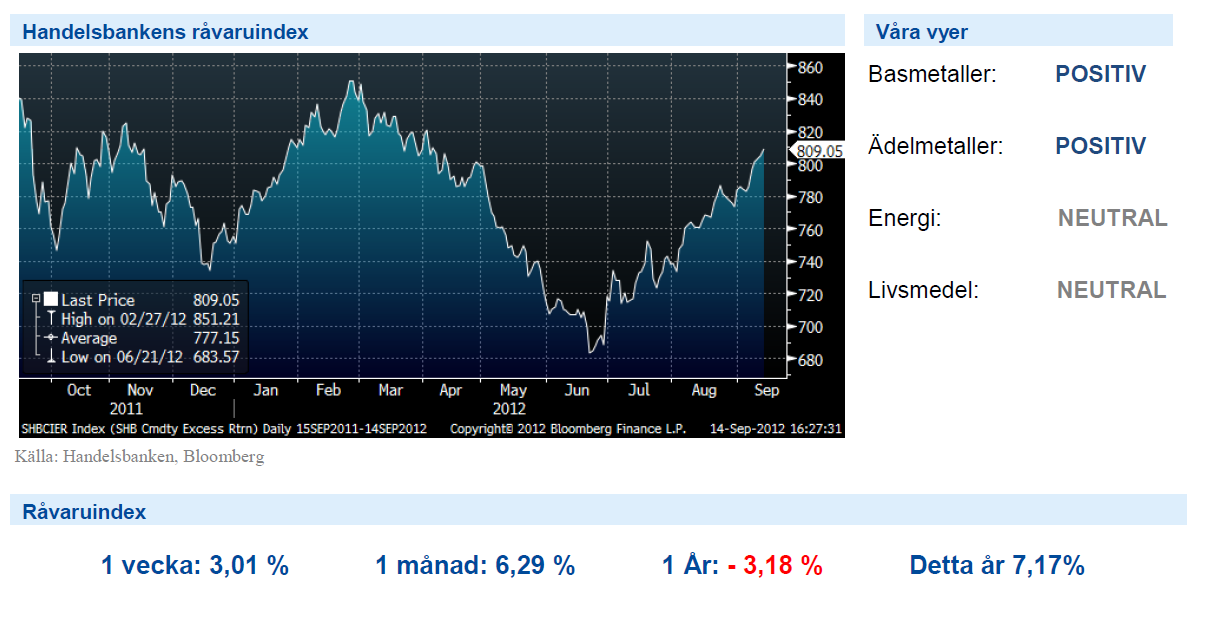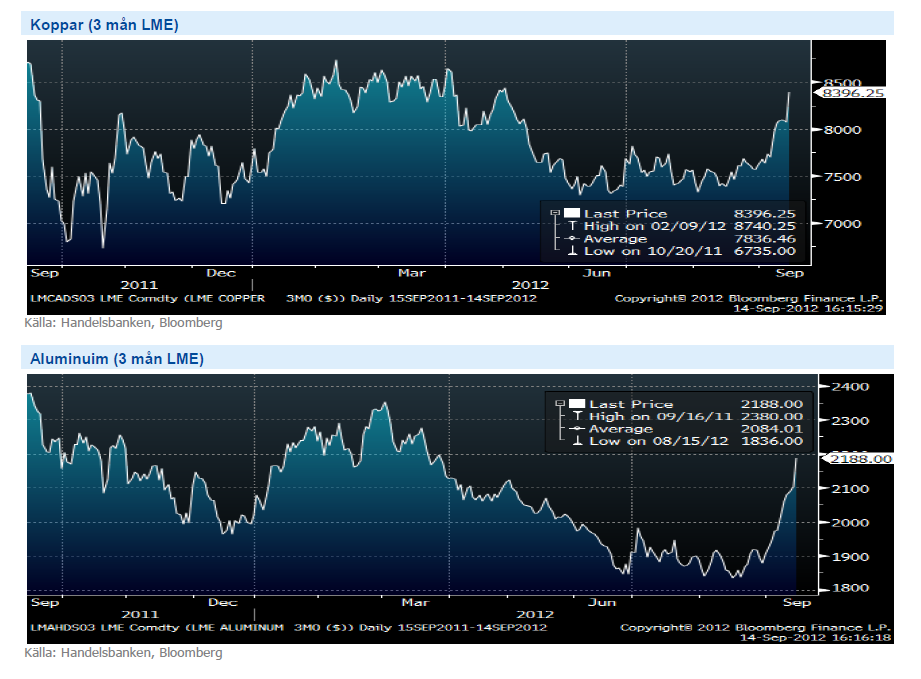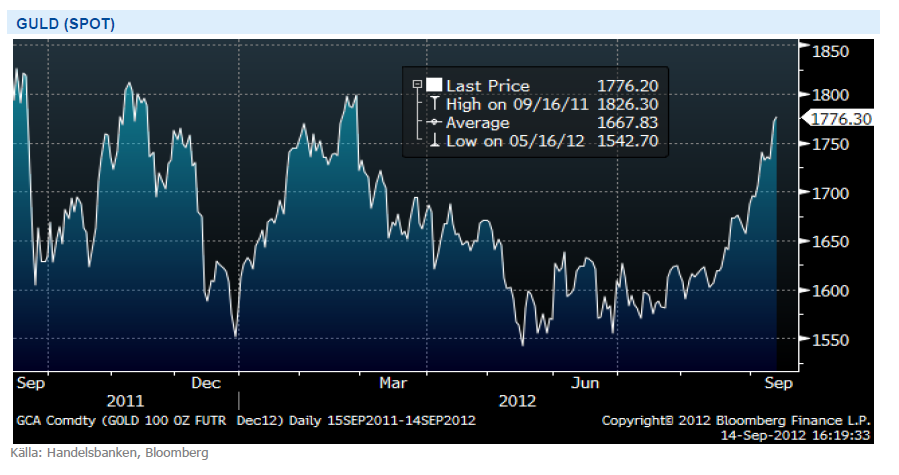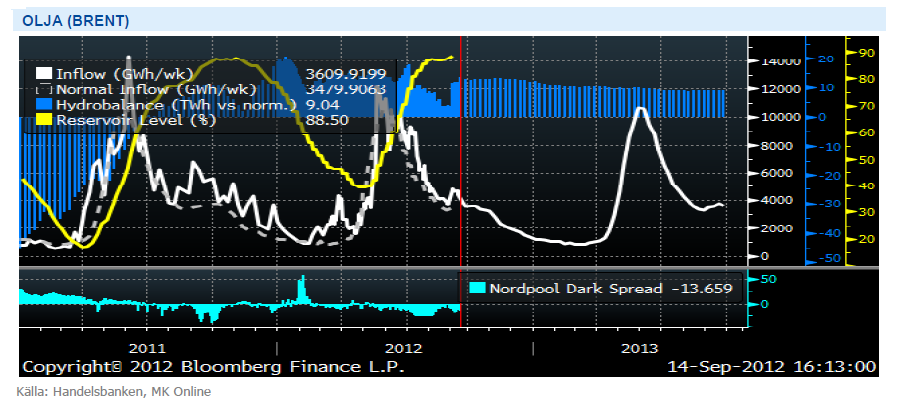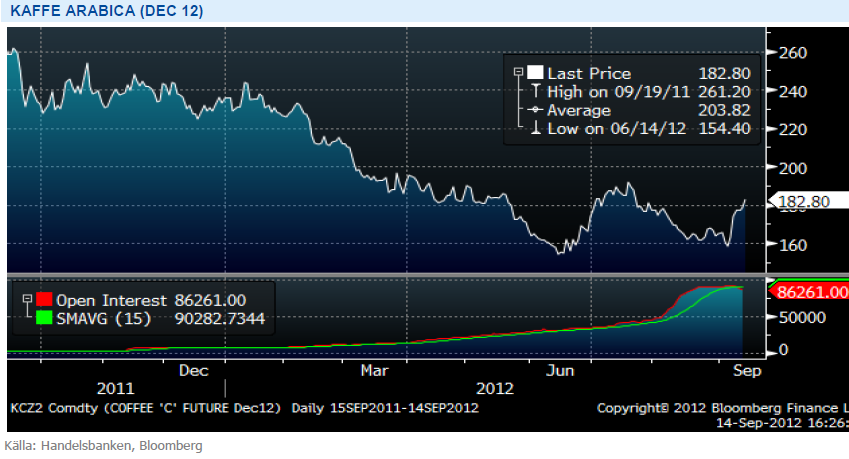Analys
SHB Råvarubrevet 14 september 2012
 Råvaror Allmänt
Råvaror Allmänt
FED överträffade marknadens förväntningar
Amerikanska centralbanken, FED överträffade marknadens förväntningar i torsdags. Fed kommer att stödköpa 40 Mdr USD per månad i bostadsobligationer samt kommer hålla räntan låg till mitten av 2015. Så långt var allt enligt förväntansbilden. Över förväntan var däremot ”tonen” från FED som indi-kerade att återköp pågår tills dess att arbetsmarknaden återhämtat sig samt att återköp kommer fort-sätta även om BNP-tillväxt går upp mot 3-3.5%, det står klart att FED är beredd att överskjuta på inflationsmålet.
För råvaror betyder det att marknaden får stimulativt stöd under en längre tid och vi förväntar oss nu en råvarumarknad som ”glider” uppåt under de kommande månaderna. Guld och silver brukar vara det som mest gynnas av ”oortodox” penningpolitik.
Basmetallerna
Basmetallerna på fortsatt uppgång
Basmetallerna fick sig en rejäl skjuts uppåt under veckan. Metallerna fick hjälp av det allmänna risksentimentet i början av veckan och fick givetvis ytterligare dragkraft när QE3 annonserades igår kväll.
Priserna är upp cirka 6 % i genomsnitt med aluminium och nickel som draglok medan koppar agerade sänke. Något som kan stödja speciellt zink- och aluminiummarknaderna framöver är rapporter om minskat utbud. Rusal, världens största aluminiumproducent, har drabbats av höga energikostnader vilket gör att de kommer dra produktionen med 3 %. Zinkproducenter i Kina har även de dragit ned produktionen till nioårslägsta. Vi är fortsatt positiva till basmetaller eftersom vi tror att stimulansåtgärderna nu kommer sprida sig i den reala ekonomin och dra upp priserna ytterligare.
Kinas makrodata har ännu inte bjudit på positiva överraskningar men Kinas dåliga konjunktur är nu inprisad i råvarorna och de faller inte när kinadata kommer ut. Vi tycker att basmetallerna, som har 50 % exponering mot Kina, handlas på attraktiva nivåer och de bjuder på en intressant uppsida när Kinas konjunkturåterhämtning kommer. Vi ser även att den positiva riskaptiten, drivet av centralbankernas stimulanser ger stöd åt prisbilden. Vi tror på: BULL BASMET H
Ädelmetaller
Rally på ädelmetaller
Feds besked igår kväll har – trots att marknaden handlat positivt inför det – ytterligare eldat på rallyt i ädelmetaller. Guldet handlar nu 1 775 doller per uns, mindre än 10 dollar från årshögsta noterat i februari, att jämföra med maj då det noterade 1 540 usd per uns. Sedan mitten på augusti, då Fed-protokollet antydde ytterligare kvantitativa lättnader har guldet stigit med 11 %.
Vi ser fortfarande utrymme för vidare prisstegring på ädelmetaller, dels drivet av ett allmänt metall-rally, dels av det faktum att guld och silver historiskt gynnats mest av den typ av stimulans Fed ägnar sig åt för tillfälet. Trots att vi handlat på QE-förväntningar under ganska lång tid bedömer vi att marknaden har gott om utrymme kvar på uppsidan då euro-krisen varit det genomgående temat ända sedan i våras.
Feds bekräftade stimulansåtgärder kommer att ge fortsatt stöd åt ädelmetallerna, lett av guld. Vi tror på: ADELMET H
Energi
Vått väder pressar elpriset
Den våta vädertrenden består och nordisk el tappar närmare 3 procent under veckan till 41.35 euro/MWh för kvartalskontraktet Q1 2013. Prognoserna pekar idag fredag på nya nederbördsmängder om 2-3 TWh över normal nivå för det kommande tio dagarna vilket i kombination med låga spotpriser, utsläppskostnader och en pressad energikolsmarknad gör att vi potentiellt kan fortsätta ned till strax under 40 nivån för Q1 2013.
Brytpriset for kolgenererad kraft, vilket brukar fungera som stöd, ligger på ca 38 euro men vi har svårt att det skall gå ändå dit eftersom vi har långt fram till vintern där man ofta söker en riskpremie för eventuell kyla och bortfall av kärnkraft. Som vi skrev i förra brevet finns det egentligen ingen faktor som pekar upp så länge vädret inte slår om till extremt torrt eller kolet finner styrka. Vi tror däremot att marknaden diskonterat för de nederbördsmängder som väntas och ligger kvar med neutral till kort position om det visar sig att hela den förväntade nederbördsmängden faller ut.
Feds tillkännagivande i kombination med politisk oro i samband med antiamerikanska protester driver Brent-oljan upp över 117 dollar mot slutet av veckan. Detta är den högsta nivån på över 4 månader. En ny omgång stödköp av räntepapper ger stöd åt oljemarknaden och vi får räkna med att oroligheterna kring Libyen, Yemen och övriga oljeproducerande länder i området kommer ge upphov till en varaktig riskpremie på marknaden. Däremot förväntas produktionen av Nordsjöolja öka med uppemot 25 procent under de kommande 4-6 veckorna till 2 miljoner fat vilket inte är så värst stora volymer men ändå tillräckligt för att reducera känsligheten för störningar på produktionssidan (och dessutom leda till att spreaden mellan wti och brent, 17.2 dollar, går ihop något. Vi förväntar oss nu att priset stabiliseras varför vi ändrar vår syn från lång till neutral.
Olja är den mest finansiellt handlade råvaran, fortsatta störningar på utbudssidan i kombination med ökad risk-vilja hos investerare efter ECBs och Feds aktioner kan driva olja ytterligare. Vi bedömer dock att det finns en finansiellt driven riskpremie i oljan på grund av oron kring Israels krigsvilja, denna kan snabbt pysa ut om situationen lugnar ner sig. Vi är därför neutrala till oljan.
Livsmedel
Torka i Brasilien – priset på kaffe stiger
Inga större rörelser på Vetemarknaden men Majs tappade däremot 2 procent under veckan efter att USDA justerat upp ingående lager säsongen 2012/2013 vilket var en följd av att den majs som skördats innan 1a september läggs till föregående säsongs skörd. Det vi reagerade mest på i rapporten var att man inte ens justerade ned siffran för Australien, de officiella Australiensiska siffrorna ligger idag på 22.5 miljoner ton medan USDA noterar 26 miljoner ton i sin rapport. Under årets Baltic Grain Exchange konferens i Köpenhamn talade vi med flertalet större aktörer som bekräftade svårigheten att finna fysiskt material på marknaden för de som måste köpa, detta kan resultera i ytterligare en prisuppgång under de kommande veckorna.
Oförändrade siffror från USDA i veckan vad gäller apelsinskörden 2011-12. Efterfrågan på apelsinjuice är fortsättningsvis låg, skördarna goda och hittills har inte odlingsområdena kring Florida drabbats av den rådande orkansäsongen. Antalet namngivna orkaner är något fler denna orkansäsong jämfört med föregående år vilket marknaden är väl medveten om och man kan de senaste veckorna se sambandet mellan priset och de kraftigare orkanernas rörelser.
Torka i Brasilien vilket kan komma att påverka den kommande skörden negativt har fått priset på Arabica kaffe att stiga under veckan. Mer nederbörd behövs de kommande veckorna för att optimera skörden och i dagsläget ser 10dygns prognosen inte lovande ut. Man ska också komma ihåg att vi nu står inför den lägre producerande Brasilianska skörden (två års skördecykel). Colombia, näst största producent av Arabica kaffe, har drabbats av ogynnsamma väderförhållanden och dåliga skördar de senaste 4 åren. En svagare El Nino skulle kunna vara gynnsamt för den kommande skörden. Positiva siffror i juli talar för en ökning av den totala colombianska skörden som avslutas i slutet av september (jämfört med året innan som producerade färre än 8M säckar). De senaste 50 åren har den genomsnittliga skörden av arabicabönor i Colombia varit 11M 60kg säckar.
Handelsbankens Råvaruindex
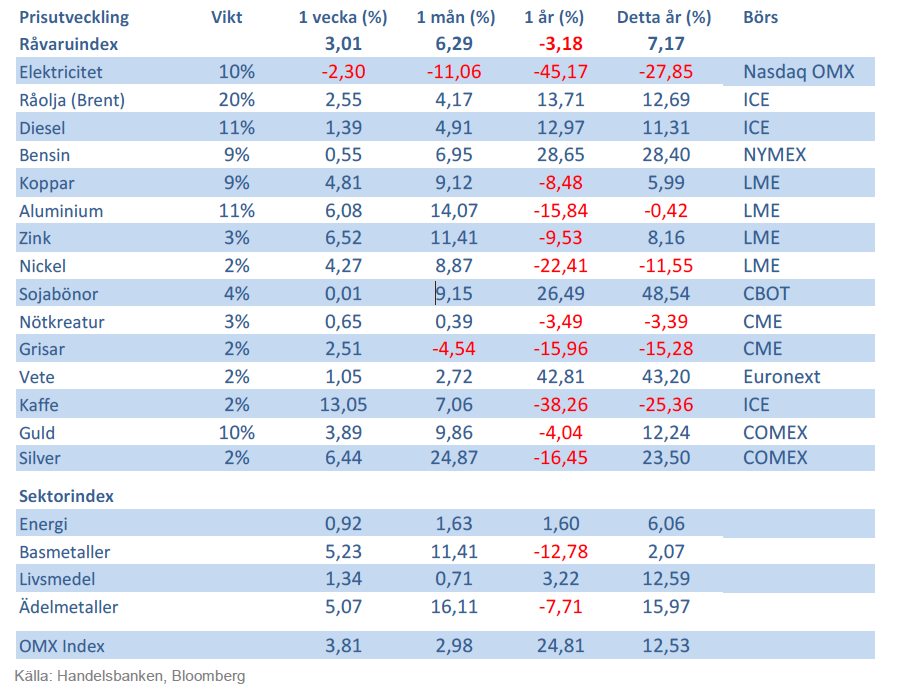
Handelsbankens råvaruindex består av de underliggande indexen för respektive råvara. Vikterna är bestämda till hälften från värdet av global produktion och till hälften från likviditeten i terminskontrakten.
[box]SHB Råvarubrevet är producerat av Handelsbanken och publiceras i samarbete och med tillstånd på Råvarumarknaden.se[/box]
Ansvarsbegränsning
Detta material är producerat av Svenska Handelsbanken AB (publ) i fortsättningen kallad Handelsbanken. De som arbetar med innehållet är inte analytiker och materialet är inte oberoende investeringsanalys. Innehållet är uteslutande avsett för kunder i Sverige. Syftet är att ge en allmän information till Handelsbankens kunder och utgör inte ett personligt investeringsråd eller en personlig rekommendation. Informationen ska inte ensamt utgöra underlag för investeringsbeslut. Kunder bör inhämta råd från sina rådgivare och basera sina investeringsbeslut utifrån egen erfarenhet.
Informationen i materialet kan ändras och också avvika från de åsikter som uttrycks i oberoende investeringsanalyser från Handelsbanken. Informationen grundar sig på allmänt tillgänglig information och är hämtad från källor som bedöms som tillförlitliga, men riktigheten kan inte garanteras och informationen kan vara ofullständig eller nedkortad. Ingen del av förslaget får reproduceras eller distribueras till någon annan person utan att Handelsbanken dessförinnan lämnat sitt skriftliga medgivande. Handelsbanken ansvarar inte för att materialet används på ett sätt som strider mot förbudet mot vidarebefordran eller offentliggörs i strid med bankens regler.
Analys
Tightening fundamentals – bullish inventories from DOE

The latest weekly report from the US DOE showed a substantial drawdown across key petroleum categories, adding more upside potential to the fundamental picture.

Commercial crude inventories (excl. SPR) fell by 5.8 million barrels, bringing total inventories down to 415.1 million barrels. Now sitting 11% below the five-year seasonal norm and placed in the lowest 2015-2022 range (see picture below).
Product inventories also tightened further last week. Gasoline inventories declined by 2.1 million barrels, with reductions seen in both finished gasoline and blending components. Current gasoline levels are about 3% below the five-year average for this time of year.
Among products, the most notable move came in diesel, where inventories dropped by almost 4.1 million barrels, deepening the deficit to around 20% below seasonal norms – continuing to underscore the persistent supply tightness in diesel markets.
The only area of inventory growth was in propane/propylene, which posted a significant 5.1-million-barrel build and now stands 9% above the five-year average.
Total commercial petroleum inventories (crude plus refined products) declined by 4.2 million barrels on the week, reinforcing the overall tightening of US crude and products.


Analys
Bombs to ”ceasefire” in hours – Brent below $70

A classic case of “buy the rumor, sell the news” played out in oil markets, as Brent crude has dropped sharply – down nearly USD 10 per barrel since yesterday evening – following Iran’s retaliatory strike on a U.S. air base in Qatar. The immediate reaction was: “That was it?” The strike followed a carefully calibrated, non-escalatory playbook, avoiding direct threats to energy infrastructure or disruption of shipping through the Strait of Hormuz – thus calming worst-case fears.

After Monday morning’s sharp spike to USD 81.4 per barrel, triggered by the U.S. bombing of Iranian nuclear facilities, oil prices drifted sideways in anticipation of a potential Iranian response. That response came with advance warning and caused limited physical damage. Early this morning, both the U.S. President and Iranian state media announced a ceasefire, effectively placing a lid on the immediate conflict risk – at least for now.
As a result, Brent crude has now fallen by a total of USD 12 from Monday’s peak, currently trading around USD 69 per barrel.
Looking beyond geopolitics, the market will now shift its focus to the upcoming OPEC+ meeting in early July. Saudi Arabia’s decision to increase output earlier this year – despite falling prices – has drawn renewed attention considering recent developments. Some suggest this was a response to U.S. pressure to offset potential Iranian supply losses.
However, consensus is that the move was driven more by internal OPEC+ dynamics. After years of curbing production to support prices, Riyadh had grown frustrated with quota-busting by several members (notably Kazakhstan). With Saudi Arabia cutting up to 2 million barrels per day – roughly 2% of global supply – returns were diminishing, and the risk of losing market share was rising. The production increase is widely seen as an effort to reassert leadership and restore discipline within the group.
That said, the FT recently stated that, the Saudis remain wary of past missteps. In 2018, Riyadh ramped up output at Trump’s request ahead of Iran sanctions, only to see prices collapse when the U.S. granted broad waivers – triggering oversupply. Officials have reportedly made it clear they don’t intend to repeat that mistake.
The recent visit by President Trump to Saudi Arabia, which included agreements on AI, defense, and nuclear cooperation, suggests a broader strategic alignment. This has fueled speculation about a quiet “pump-for-politics” deal behind recent production moves.
Looking ahead, oil prices have now retraced the entire rally sparked by the June 13 Israel–Iran escalation. This retreat provides more political and policy space for both the U.S. and Saudi Arabia. Specifically, it makes it easier for Riyadh to scale back its three recent production hikes of 411,000 barrels each, potentially returning to more moderate increases of 137,000 barrels for August and September.
In short: with no major loss of Iranian supply to the market, OPEC+ – led by Saudi Arabia – no longer needs to compensate for a disruption that hasn’t materialized, especially not to please the U.S. at the cost of its own market strategy. As the Saudis themselves have signaled, they are unlikely to repeat previous mistakes.
Conclusion: With Brent now in the high USD 60s, buying oil looks fundamentally justified. The geopolitical premium has deflated, but tensions between Israel and Iran remain unresolved – and the risk of missteps and renewed escalation still lingers. In fact, even this morning, reports have emerged of renewed missile fire despite the declared “truce.” The path forward may be calmer – but it is far from stable.
Analys
A muted price reaction. Market looks relaxed, but it is still on edge waiting for what Iran will do

Brent crossed the 80-line this morning but quickly fell back assigning limited probability for Iran choosing to close the Strait of Hormuz. Brent traded in a range of USD 70.56 – 79.04/b last week as the market fluctuated between ”Iran wants a deal” and ”US is about to attack Iran”. At the end of the week though, Donald Trump managed to convince markets (and probably also Iran) that he would make a decision within two weeks. I.e. no imminent attack. Previously when when he has talked about ”making a decision within two weeks” he has often ended up doing nothing in the end. The oil market relaxed as a result and the week ended at USD 77.01/b which is just USD 6/b above the year to date average of USD 71/b.

Brent jumped to USD 81.4/b this morning, the highest since mid-January, but then quickly fell back to a current price of USD 78.2/b which is only up 1.5% versus the close on Friday. As such the market is pricing a fairly low probability that Iran will actually close the Strait of Hormuz. Probably because it will hurt Iranian oil exports as well as the global oil market.
It was however all smoke and mirrors. Deception. The US attacked Iran on Saturday. The attack involved 125 warplanes, submarines and surface warships and 14 bunker buster bombs were dropped on Iranian nuclear sites including Fordow, Natanz and Isfahan. In response the Iranian Parliament voted in support of closing the Strait of Hormuz where some 17 mb of crude and products is transported to the global market every day plus significant volumes of LNG. This is however merely an advise to the Supreme leader Ayatollah Ali Khamenei and the Supreme National Security Council which sits with the final and actual decision.
No supply of oil is lost yet. It is about the risk of Iran closing the Strait of Hormuz or not. So far not a single drop of oil supply has been lost to the global market. The price at the moment is all about the assessed risk of loss of supply. Will Iran choose to choke of the Strait of Hormuz or not? That is the big question. It would be painful for US consumers, for Donald Trump’s voter base, for the global economy but also for Iran and its population which relies on oil exports and income from selling oil out of that Strait as well. As such it is not a no-brainer choice for Iran to close the Strait for oil exports. And looking at the il price this morning it is clear that the oil market doesn’t assign a very high probability of it happening. It is however probably well within the capability of Iran to close the Strait off with rockets, mines, air-drones and possibly sea-drones. Just look at how Ukraine has been able to control and damage the Russian Black Sea fleet.
What to do about the highly enriched uranium which has gone missing? While the US and Israel can celebrate their destruction of Iranian nuclear facilities they are also scratching their heads over what to do with the lost Iranian nuclear material. Iran had 408 kg of highly enriched uranium (IAEA). Almost weapons grade. Enough for some 10 nuclear warheads. It seems to have been transported out of Fordow before the attack this weekend.
The market is still on edge. USD 80-something/b seems sensible while we wait. The oil market reaction to this weekend’s events is very muted so far. The market is still on edge awaiting what Iran will do. Because Iran will do something. But what and when? An oil price of 80-something seems like a sensible level until something do happen.
-

 Nyheter4 veckor sedan
Nyheter4 veckor sedanStor uppsida i Lappland Guldprospekterings aktie enligt analys
-

 Nyheter4 veckor sedan
Nyheter4 veckor sedanSilverpriset släpar efter guldets utveckling, har mer uppsida
-

 Nyheter3 veckor sedan
Nyheter3 veckor sedanUppgången i oljepriset planade ut under helgen
-

 Nyheter2 veckor sedan
Nyheter2 veckor sedanMahvie Minerals växlar spår – satsar fullt ut på guld
-

 Nyheter3 veckor sedan
Nyheter3 veckor sedanLåga elpriser i sommar – men mellersta Sverige får en ökning
-

 Analys3 veckor sedan
Analys3 veckor sedanVery relaxed at USD 75/b. Risk barometer will likely fluctuate to higher levels with Brent into the 80ies or higher coming 2-3 weeks
-

 Nyheter2 veckor sedan
Nyheter2 veckor sedanOljan, guldet och marknadens oroande tystnad
-

 Nyheter2 veckor sedan
Nyheter2 veckor sedanJonas Lindvall är tillbaka med ett nytt oljebolag, Perthro, som ska börsnoteras


